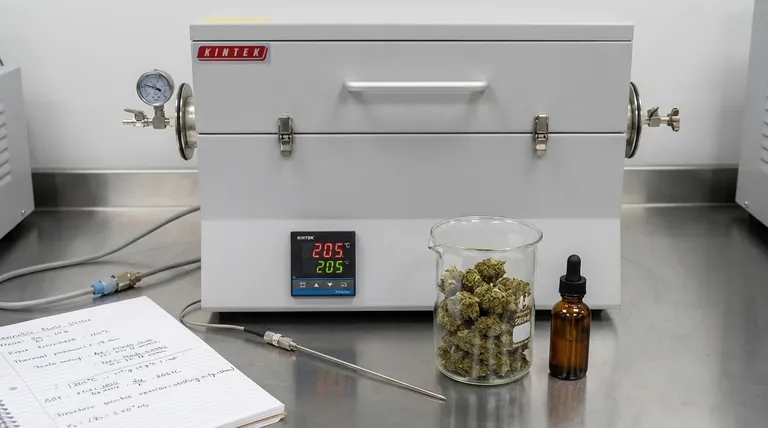To be precise, significant degradation of THC begins to accelerate when temperatures exceed 392°F (200°C). Below this point, THC is relatively stable, but it's crucial to understand that damage isn't an on/off switch. The process is a function of both temperature and time, and it begins much earlier with the loss of other valuable compounds like terpenes.
The core principle is managing a delicate balance: you must apply enough heat to activate cannabis compounds (decarboxylation) without applying so much that you degrade them or destroy the aromatic terpenes that shape the experience.

Activation vs. Degradation: A Tale of Two Temperatures
Understanding the difference between activating THC and destroying it is the most critical concept for preserving potency. Raw cannabis contains very little psychoactive THC; it primarily contains THCA, a non-psychoactive acid. Heat is what converts it.
What is Decarboxylation?
Decarboxylation is the scientific term for activating cannabinoids. It is a chemical reaction that removes a carboxyl group from THCA, converting it into the psychoactive THC we associate with cannabis.
This process requires heat, but a gentle, controlled heat.
The Sweet Spot for Activation
The ideal temperature range for decarboxylation is between 220–245°F (105–120°C). Holding cannabis at this temperature for 30-45 minutes provides the optimal conversion of THCA to THC with minimal degradation.
This is the foundational step for making edibles, tinctures, or any infused product.
The Point of Degradation
Once temperatures climb past the boiling point of THC (315°F / 157°C) and approach 392°F (200°C), degradation accelerates.
At these higher temperatures, THC begins to break down and convert into a different cannabinoid called Cannabinol (CBN). While not a total loss, CBN is known for producing a more sedative, sleepy effect, fundamentally changing the character of the product.
Understanding the Trade-offs
Choosing the right temperature is always a balancing act. What you gain in one area, you may lose in another.
Potency vs. Flavor
The most significant trade-off is between cannabinoid potency and terpene preservation. Terpenes, the aromatic compounds responsible for the flavor and smell of cannabis, are highly volatile.
Many terpenes have boiling points much lower than THC, some starting as low as 250°F (121°C). Exposing cannabis to high heat will activate THC quickly but will burn off these delicate compounds, resulting in a less flavorful and nuanced experience.
Speed vs. Preservation
You can decarboxylate cannabis faster at higher temperatures, but you run a much greater risk of overshooting the mark and degrading THC into CBN.
The "low and slow" method is the industry standard because it offers the highest degree of control and ensures maximum preservation of both cannabinoids and terpenes.
The Role of Time
It's important to remember that heat damage is a product of temperature and time. A brief exposure to a high temperature (like in a vaporizer) is very different from prolonged exposure (like baking edibles for an hour).
Even at room temperature, slow degradation occurs over months, accelerated by exposure to light and oxygen. This is why proper storage in a cool, dark, airtight container is essential.
How to Apply This to Your Goal
Your ideal temperature depends entirely on your objective.
- If your primary focus is maximum potency for edibles: Decarboxylate your cannabis in an oven at 230°F (110°C) for 40 minutes before infusing it into butter or oil. Never exceed 300°F (150°C) in your final baking recipe.
- If your primary focus is flavor and effect when vaping: Start at a low temperature around 320-350°F (160-177°C) to experience the full terpene profile, then gradually increase it to vaporize the THC and other cannabinoids.
- If your primary focus is long-term storage: Keep your cannabis in an airtight, opaque container in a cool, dark place (ideally below 70°F / 21°C) to prevent the slow degradation caused by heat, light, and air.
Ultimately, mastering temperature control gives you the power to fine-tune your results and achieve your desired outcome with consistency.
Summary Table:
| Temperature Range | Process & Effect | Key Takeaway |
|---|---|---|
| 220–245°F (105–120°C) | Ideal Decarboxylation: Converts THCA to active THC. | The 'sweet spot' for activation with minimal degradation. |
| 315°F (157°C) | THC Boiling Point: THC begins to vaporize. | Critical threshold for vaporization. |
| >392°F (200°C) | Significant Degradation: THC rapidly converts to sedative CBN. | The point where damage accelerates; avoid prolonged exposure. |
Achieve Perfect Results with Precise Temperature Control
Mastering the delicate balance of heat is key to unlocking the full potential of your cannabis, whether for edibles, extracts, or research. Inconsistent temperatures can lead to lost potency, degraded terpenes, and unpredictable outcomes.
KINTEK specializes in the lab equipment and consumables that laboratories rely on for precise, reliable thermal processing. From controlled ovens for perfect decarboxylation to stable heating mantles for safe extraction, our products provide the accuracy and consistency you need to preserve valuable compounds and ensure reproducible results every time.
Stop guessing and start controlling. Let our experts help you select the right equipment for your specific application.
Contact KINTEK today to discuss your laboratory's needs and ensure your processes are as precise as your science.
Visual Guide

Related Products
- 1700℃ Laboratory Quartz Tube Furnace with Alumina Tube Tubular Furnace
- 1400℃ Laboratory Quartz Tube Furnace with Alumina Tube Tubular Furnace
- High Temperature Muffle Oven Furnace for Laboratory Debinding and Pre Sintering
- 1700℃ Muffle Oven Furnace for Laboratory
- Laboratory Muffle Oven Furnace Bottom Lifting Muffle Furnace
People Also Ask
- What is the ceramic tube high temperature? From 1100°C to 1800°C, Choose the Right Material
- What tube is used for tubular furnace? Choose the Right Material for Temperature & Atmosphere
- What are the tubes in a furnace called? Understanding the Role of the Working Tube
- How does a tube furnace work? Master Precise Thermal and Atmospheric Control
- What precautions should be taken when using a tube furnace? Ensure Safe, Effective High-Temperature Processing



















